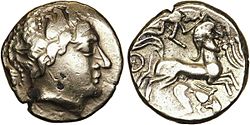Andecavi

The Andecavi (also Andicavi, Andegavi, or Andigavi) were a Gallic tribe dwelling in Aremorica during the Roman period.
Name
[edit]They are mentioned as Andecavi (var. andic-, andeg-, andig-) by Pliny (1st c. AD),[1] Andecavi and Andecavos by Tacitus (early 2nd c. AD),[2] A̓ndíkauoi (Ἀνδίκαυοι; var. Ὀνδικαοῦαι, Ὠνδικαοῦαι) by Ptolemy (2nd c. AD),[3] and as Andicavos (var. andegauus, andecauos, andigabos, andigabus, andicabos) by Orosius (early 5th c. AD).[4][5]
The etymology of the ethnonym Andecavī remains uncertain. Ande- is a Gaulish intensifying suffix, but the interpretation of the second element is difficult.[6] Andecaui could mean ''those of the big hollow', by deriving the name from the Celtic root *kuwo- ('hollow'; cf. OIr. cúa, 'hollow, cavity'; Welsh keu, 'hollow, closed'; OBr. cau, 'closed, covered').[7] Pierre-Yves Lambert has also suggested a connection with a shortened form of the Celtic root *kawaro- ('hero, champion'; cf. OIr. cuar 'hero', Middle Welsh cawr 'giant').[8]
The city of Angers, attested ca. 400 AD as civitas Andecavorum ('civitas of the Andecavi', Andegavis in 861–882, Angieus in 1127), and the region of Anjou, attested in 767 as pago Andegavinse (in Andecavo in 797, Anjau ca. 1071–1127), are named after the Gallic tribe.[9]
Geography
[edit]
The territory of the Andecavi roughly corresponded with the diocese of Angers, Anjou, in the department Maine-et-Loire in present-day France. Although Caesar locates the Andes "near the Ocean", they held no coast and were located inland along the Loire river.[10]
History
[edit]In Book 3 of the Bellum Gallicum, Caesar says that the Andes provided winter quarters for Publius Crassus after his mission into Armorica, which brought several Gallic polities into relations with Rome.[11] Over the winter of 57–56 BC, the Romans built a fleet on the Loire under the command of Decimus Brutus, presumably in preparation for an invasion of Britannia, but which was instead called into action against the Veneti when Armorican objections were raised.
The Andes, led by Dumnacus, played a significant role in the continuing war against Rome after the defeat of Vercingetorix at Alesia. Dumnacus's efforts are recounted by Aulus Hirtius in his continuation of the Bellum Gallicum (Book 8), which covers the two years of the war after Caesar had declared his mission accomplished. Dumnacus lay siege to Limonum (present-day Poitiers), an oppidum of the Pictones, and engaged without success the Roman relief army under the command of Gaius Caninius Rebilus. When additional Roman forces arrived on the scene, Dumnacus was forced to lift the siege and retreat. The army of the Andes was pursued by the Romans and suffered heavy casualties. In a decisive battle the following day, the Romans killed some 12,000 men. Dumnacus escaped, and when Armorica surrendered, he went into self-imposed exile.[12]
References
[edit]- ^ Pliny. Naturalis Historia, 4:107.
- ^ Tacitus. Annales, 3:41.
- ^ Ptolemy. Geōgraphikḕ Hyphḗgēsis, 2:8:8.
- ^ Orosius. Historiae Adversus Paganos, 6:8:7.
- ^ Falileyev 2010, entry 3008.
- ^ Delamarre 2003, pp. 45, 112.
- ^ Delamarre 2003, p. 112.
- ^ Lambert 2005, p. 222.
- ^ Nègre 1990, p. 151.
- ^ Michel Rambaud, C. Iulius Caesar De Bello Gallico, secundus tertiusque libri, text, introduction and commentary (Paris 1965), p. 144, note to 7.2.
- ^ Caesar, Bellum Gallicum 2.33 and 3.7.
- ^ Aulus Hirtius, Bellum Gallicum 8.26–31.
Bibliography
[edit]- Delamarre, Xavier (2003). Dictionnaire de la langue gauloise: Une approche linguistique du vieux-celtique continental (in French). Errance. ISBN 9782877723695.
- Falileyev, Alexander (2010). Dictionary of Continental Celtic Place-names: A Celtic Companion to the Barrington Atlas of the Greek and Roman World. CMCS. ISBN 978-0955718236.
- Lambert, Pierre-Yves (2005). "The place names of Lugdunensis [Λουγδουνησία]". In de Hoz, Javier; Luján, Eugenio R.; Sims-Williams, Patrick (eds.). New approaches to Celtic place-names in Ptolemy's Geography. Ediciones Clásicas. pp. 215–251. ISBN 978-8478825721.
- Nègre, Ernest (1990). Toponymie générale de la France (in French). Librairie Droz. ISBN 978-2-600-02883-7.


